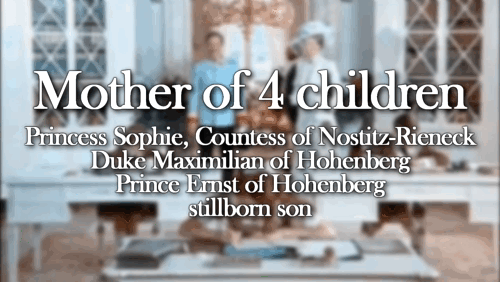#Archduchess Friedrich Franz of Austria Teschen
Explore tagged Tumblr posts
Photo

The four kids of Archduchess Elisabeth Fransiska and Archduke Karl Ferdinand of Austria Teschen, Friedrich Franz (1856-1936), Maria Cristina , later Queen regent of Spain (1858-1929), Karl Stephan (1860-1933) and Eugen (1863-1954) . Circa 1866
#Antique#Vintage#Victorian#1860s#Victorian children fashion#Royalty#Austria#Habsburg#Archduchess MAria Cristina of Austria Teschen#Queen Regent MAria Cristina of Spain#Archduchess Friedrich Franz of Austria Teschen#Archduke Karl Stephan of Austria-Teschen#Archduke Eugen of Austria Teschen
28 notes
·
View notes
Photo










House of Chotek & of Habsburg: Countess Sophie Chotek of Chotkowa and Wognin
Sophie was born as the fifth child of Count Bohuslav Chotek of Chotkow and Wognin and his wife Countess Wilhelmine Kinsky of Wchinitz and Tettau. Her siblings were Count Wolfgang Chotek, Countess Zdenka Chotek, Princess Marie of Thun and Hohenstein, Countesses Karoline and Henriette of Nostitz-Rieneck, Countess Oktavia of Schönburg-Glachau and Countess Antoinette Wuthenau-Hohenthurm.
Sophie grew up in Dresden where her father had worked as diplomat. She had received an education and led the household of her father after her mother had died. When she fell for her future husband Archduke Franz Ferdinand, most of her sisters were already married and one of them even served Crown Princess Stéphanie of Austria-Hungary as a lady-in-waiting. When exactly the couple actually met for the first time is debated to this day. The time frame is somewhen between 1894 and 1897. However this may be, they were able to spent a few days icognito at Bad Neuenahr in 1898 with the help of a former lady-in-waiting of Franz Ferdinand’s aunt Empress Elisabeth.
The relationship only became public in 1899. The year before, Sophie had made clear she wanted to live closer to her lover, since she was still living with her father in Dresden. But Franz Ferdinand wanted to avoid the Viennese gossip and suggested she should apply as a lady-in-waiting to Archduchess Isabella, The Duchess of Teschen, who lived with her family in Bratislava. Isabella was supposedly a difficult mistress to please, so Sophie was reluctant but eventually did apply and received the post. From now on, Franz Ferdinand accepted every invitation of Archduke Friedrich’s family and visited them twice or thrice a week. Isabella hoped he was interested in her eldest daughter Archduchess Maria Christina of Austria-Teschen. One day, Isabella discovered a locket that Franz Ferdinand had dropped on the tennis court and opened it. She had expected to find a picture of her daughter in it but instead she found one of Sophie inside.
As soon as the relationship became public, the court tried to separate the couple. Sophie was not of high enough rank for a member of the House of Habsburg’s main line and heir to the throne, although her family had been nobles since the middle ages. Only when Franz Ferdinand’s stepmother Infanta Maria Theresa of Portugal spoke to Emperor Franz Joseph, the couple received permission to marry morganatically on April 8th, 1900, which they did less than three months later on July 1st. The condition was that Franz Ferdinand signed a document which effectively removed his future children from the line of succession and prevented him from crowning, in case of a succession to the throne, Sophie Empress of Austria, Queen of Hungary, Bohemia, Croatia or any other Habsburg realm or even making her an archduchess. This was especially important since Hungary did not practise the concept of morganatical marriages but instead viewed all marriages as equal. For her wedding, Sophie received the title of Fürstin (Princess) of Hohenberg and the style of Serene Highness. Nevertheless, Sophie was treated as a second-class noble by the Viennese society. The only one she was closed with in the Imperial family was Crown Prince Rudolf’s widow Princess Stéphanie of Belgium.
Only in 1909, after the birth of all of her children, she received the elevation to Duchess and the style of a Highness. She received many congratulation letters for it, one of them came form the German Emperor Wilhelm II who was a friend of her husband. But while her husband ranked only below The Emperor as his heir, she ranked behind all the archduchesses as well as the mediatized princesses and countess of Austria and Hungary. This difference in rank kept some courts from hosting the couple as it was difficult to do so without making any mistakes. But this did not keep the Romanian King Karl I. and his wife Elisabeth of Wied in 1909 and the British King George V and his wife Mary of Teck in 1913 from hosting them.
A little more than half a year after their visit to Britain, Sophie and Franz Ferdinand were dead. They were assassinated in Sarajevo. While he was shot in the neck, a bullet hit her in the abdomen. Their last recorded conversation was her asking him what had happened to him and him begging her to stay alive for the children while calling her by her nickname Sopherl. The murder of Sophie and Franz Ferdinand is regarded as the spark that set World War I in motion. Even in death, protocol took presedence. Franz Ferdinand had the right to be buried in the Imperial Crypt but Sophie did not. Instead they had requested to be buried together at the Habsburg’s summer home of Arstetten castle.
Their children Sophie, Maximilian and Ernst were raised by Sophie’s sister Henriette while their legal guardian became their uncle and good friend of their father Prince Jaroslav of Thun and Hohenstein. Sophie and Maximilian decided to forgive Nedeljko Čabrinović for the murder of their parents after her showed regret for doing it while Ernst did not sign the letter they wrote to him. Ernst and Maximilian were later imprisoned in a concentration camp in Dachau for making anti-Nazi statements after the Annextion of Austria by The Third Reich. But they survived their imprisonment. Through her daughter Sophie is an ancestor of the actors Friedrich and Max von Thun. The latter actually played Franz Ferdinand’s cousin Crown Prince Rudolf in a miniseries in 2006.
// Florinda Bolkan in The Day That Shook the World (1975)
______________________________________________________________
Requested by anonymous
#perioddramaedit#women in history#historyedit#Sophie Chotek#European history#Austrian history#Bohemian history#House of Habsburg#House of Habsburg-Lorraine#House of Chotek#sophie chotek von chotkowa#Sophie Chotek of Chotkowa and Wognin#1900s#20th century#1800s#1890s#19th century#morganatic wives#Duchess Sophie of Hohenberg#period drama#The Day That Shook The World#requests#historic women
181 notes
·
View notes